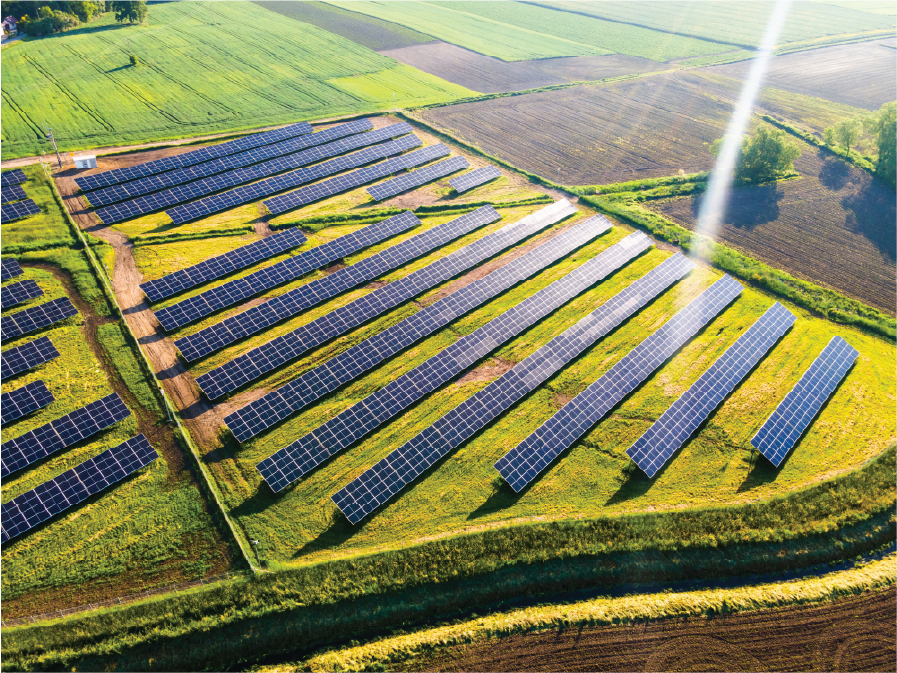The Rise of Green Infrastructure: What it Means for Property Owners and Conveyancers

Across the UK, renewable energy infrastructure projects are becoming increasingly common with wind and solar farms under construction and rapidly reshaping the landscape. These projects are central to the government’s push for a greener, more sustainable future, aiming to power the nation without compromising the planet by reducing carbon emissions to meet growing energy demands. As of early 2025, over 42% of the UK’s energy production comes from renewable sources, with wind power alone contributing nearly 30%. But while these projects support national climate goals, they also raise important questions: what impact do these developments have on the homeowners and communities living in their shadow?
In Faversham, Kent, Cleve Hill Solar Park is now the largest solar farm in the UK with 880,000 solar panels spread across over 900 acres of land. The development also includes a 150 MW lithium ion battery storage facility. Whilst this project will create enough clean energy to power more than 90,000 homes, local residents and property owners have concerns. The scale and aesthetics of the development have proved tough to swallow for people living nearby who have opposed the farm at every turn. Local campaigners have described the panels as “double decker buses”, spoiling views and harming local wildlife and nature reserves. The construction of this park also has a big impact on the daily life of residents in nearby villages with increased road congestion, dust and noise.
Projects such as this can also have an impact on house prices in the area, research shows homes within 3 miles of utility-scale solar can drop 5% in value shortly after construction. Another such project, Botley West Solar Farm in Hampshire, is currently still in the planning stage, however, homeowner impacts will be similar to the Cleve Hill concerns, such as construction disruption and potential property depreciation.
Even offshore wind farms, such as East Anglia One, Two and Three off the coast of Suffolk, are causing a significant impact on homeowners. While offshore wind farms are generally more distant from residential areas, they drive the need for new onshore electricity infrastructure, like the proposed Norwich–Tilbury Great Grid upgrade. This upgrade is required to bring the wind power ashore, but has the potential to impact house prices nearby and disrupt daily life.
Not only are these energy infrastructure projects causing distress to local residents, but they’re also creating significant challenges for conveyancers with transactions being delayed or even falling through entirely. Projects such as these highlight the need for conveyancers to ensure they are doing their due diligence by ensuring a planning search is included in their search pack. These searches reveal:
- Nationally Significant Infrastructure Projects (NSIPs)
- Nearby development zones and land use changes
- Long-term risks that could affect your client’s investment
- Detailed insights into local planning activity
A standalone planning search, or a combined environmental search which includes planning data, can be ordered. Either one will alert your clients to any upcoming developments in the local area. It is essential to give your clients a clear picture of what could be built in their back garden and help them make an informed decision about the investment they are looking to make.
As we look towards the future, the need for clean, renewable energy will only increase, and infrastructure projects like offshore wind farms, solar parks, and major grid upgrades will become more common. From the wind farms off the Suffolk coast to the new solar farm in Kent, these developments promise environmental benefits but threaten homeowners, buyers and conveyancing transactions. For conveyancers, this means a shift in mindset is vital. Environmental searches are no longer simply a box to tick. Conveyancers must take proactive steps to identify nearby or upcoming energy infrastructure projects and advise clients transparently about potential long-term impacts.
Discover more about why planning risk matters here.
For further information, please contact our customer services team or speak to your account manager.

%20magenta.svg)


